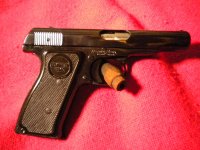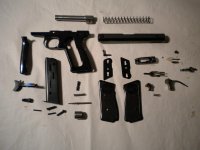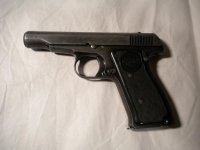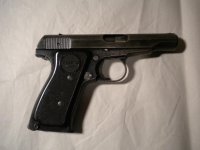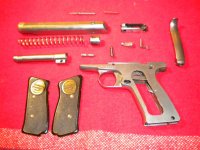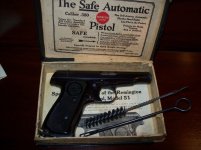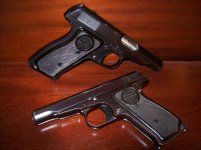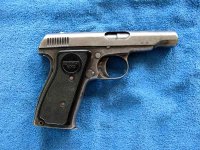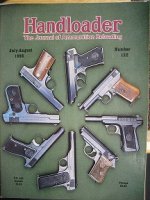Guys, Thanks for the good info!
Here's some additional info about the Remington Model 51...
"The Remington Model 51 was designed by John D. Pedersen prior to the First World War. The first patent application on the gun was filed in 1915. In 1920, seven patents were issued for the weapon. Six went to John Pedersen, and one went to Crawford C. Loomis, both employees of the Remington Arms Company. Between 1921 and 1926, an additional 25 patents were granted for various aspects of the gun's mechanism, most to Pedersen. Many of the patented mechanisms were never utilized in a production gun. One has only to hold the Remington 51 to feel its quality. The first thing you notice is how well the grip fits your hand--the result of extensive testing with hand molds to determine the correct size and shape for the average hand. Similar effort went into calculating the correct grip angle to allow the gun to point naturally. Very few guns feel so much like an extension of the hand as does the Remington 51. W.H. B. Smith says: "With the sole exception of the Luger, and the new German Walther P38, the Walther PPK, Sauer-38 and Mauser HSc (all foreign developments) this Remington 51 is probably the best-balanced, most-instinctive-pointing pistol ever made." Some of the Remington advertising actually described the pistol as "self aiming." R.K. Wilson says the Remington 51 is "...in the opinion of many authorities, the best pocket self-loading pistol ever designed..."
The gun has three safeties: a thumb-operated safety, a grip safety, and a magazine safety. The grip safety locks the disconnector, locks the sear in the hammer notch, locks the slide, and serves two additional functions. Since the grip safety does not pop out unless the gun is cocked, it acts as a cocked weapon indicator. It also serves as a lock open device for the slide (if released when the slide is retracted). Squeezing the grip safety with the slide locked open will cause the slide to close and, if a full magazine has been previously inserted, a round will be chambered. The thumb safety cannot be engaged unless the hammer is cocked, and when in the safe position it locks the grip safety so it cannot be disengaged. Interestingly enough, the thumb safety does not appear on the original patent drawings, though it did appear on the known prototypes. Remington advertised that the gun could be carried safely with only the grip safety in operation, but the thumb safety could be utilized by those who preferred a more positive lock. The Model 51 also has a magazine safety which prevents it from being fired when the magazine is not inserted. The magazine safety did not appear on the prototypes.
The unique mechanism of the Remington 51 is rather difficult to describe in words. It has been labeled as a "momentum block" system and as a "blowback/recoil" system, in an effort to differentiate it from a simple blowback action, a delayed blowback action, or a standard locked recoil action. R.K. Wilson considered it a type of delayed blowback mechanism, and that seems reasonable to me, though others certainly disagree. The gun consists of the usual receiver and slide components, but the breech block is in two parts. Only the rear part of the breech block, against which the rear of the firing pin rests, is an integral portion of the slide. The other half of the breech block is independent of both slide and receiver, and contains the firing pin, firing pin spring, and the extractor. When recoil begins, the slide moves toward the rear. The moveable portion of the breach block moves to the rear with the slide approximately 0.083 inches, and stops, remaining locked to the receiver. Hence, with the shell not yet ejected, the breech is effectively sealed until the bullet exits the barrel and breech pressure drops to a safe level. The slide continues its rearward motion for a further 0.2 inches, whereupon the moveable portion of the breech block is lifted out of engagement with the receiver and effectively becomes part of the slide for the rest of its travel. The cartridge is ejected in the usual manner; a new round is stripped from the magazine and chambered by the returning slide. An advantage of Pedersen's moveable breech block design is that it allows for a lighter slide than a straight blowback operated pistol, and hence an overall lighter weapon.
Remington introduced the Model 51 for the civilian market, producing only 25 in 1918 but ramping up to full production in 1919. Production declined steadily in succeeding years, and ended in 1927. Approximately 54,518 Model 51s were made. The .380 was designated the "Series of 1918."
In late 1943 Major General Kenyon A. Joyce visited Patton at his headquarters in Sicily. He saw that Patton was wearing a revolver and suggested he should have an automatic pistol. Joyce tried to get his brother-in-law to obtain a Remington 51 and send it to him to give to Patton, but apparently the brother-in-law was unable to locate one. So when Joyce returned to the U.S. he contacted Roy C. Swan of Remington to see if he could obtain one. Swan located a used one in Denver and had it refurbished at the Remington Factory. The gun was engraved "To George Patton / From his shooting partner of many years / Kenyon Joyce." Patton had the standard grips replaced with wooden ones with three ivory stars inset. There are a number of photographs of him wearing the Remington: the three stars stand out clearly in old black and white photographs. When he was promoted in 1945 Patton had new four-star grips made. This is the gun he wore for the rest of the war, as well as after he returned to the States.
W.H.B. Smith states that the Model 51's "... manufacture was discontinued, because the introduction of firearms laws made manufacture economically unsound." He is referring to the National Firearms act of 1934, which forced pistol and machine gun manufacturers to register and pay a tax on all sales. But economic factors were involved as well. Sales of the Model 51 were never robust and production ended in 1927. After the market crash of 1929, hardly anyone in the U.S. could afford to buy guns. Revolvers were still considered the only reliable handguns by most shooters, and in the U.S. only Colt continued to manufacture automatics after 1929. By 1932 Remington was losing as much as one million dollars per year, and in 1933 E.I. du Pont de Nemours & Company purchased a controlling interest in Remington and proceeded to reorganize the company. Perhaps this reorganization resulted in the elimination of the unprofitable pistol line. At the end of 1934 Remington posted a modest profit of $142,589. By 1936 the company stock was paying dividends again. But Remington did not manufacture another handgun until 1963 (the XP-100 single-shot). The Model 51 has never been revived.
The "momentum block" mechanism of the Model 51 reduces felt recoil and helps make the gun easier to shoot, more accurate, and lighter. A quick look at the drawing of the moveable breech block on the Model 51 will give an idea of the complex machining required to manufacture it and the slide with which it mates. Built like a watch. These guns were known to function flawlessly."

